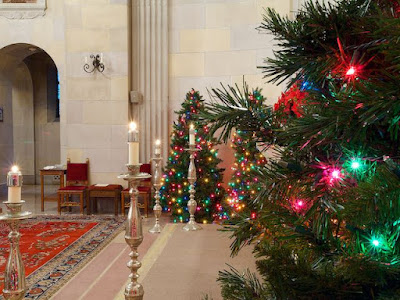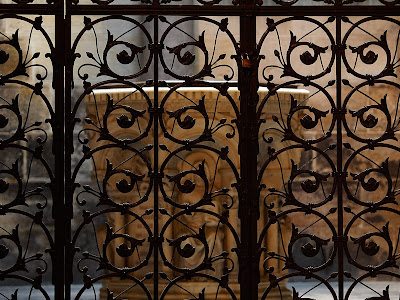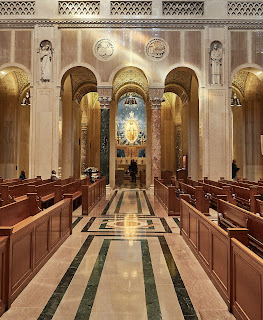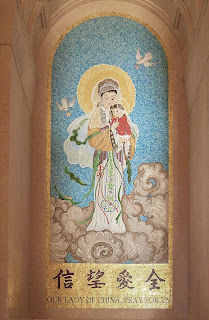Venite adoremus, Dominum
O pridite molimo Jezusa
让我们齐来朝 他主基督!
Ó vinde adoremos Cristo é o Senhor.
O come let us adore Him, Christ the Lord
We heard the readings of the Mass at midnight, readings that were and will be heard, by billions of people worldwide. The final words of the chorus of one of the most beloved of all Christmas hymns will be sung throughout the world in Latin, Slovenian, Mandarin Chinese, Portuguese, English, and every other known tongue.
As we gather to celebrate the Great Feast of the Nativity of the Lord our thoughts may drift back to other years, sometimes just a few years back while others go back more decades than we care to count. We may recall THE BEST CHRISTMAS EVER, the one during which we were being crushed with pain, or one that was somewhere in between.
We may recall the last Christmas with a loved one when all seemed right with the world, or the first Christmas without a loved one when nothing seemed the way it should have been. We may recall that Christmas as a kid when we stayed awake for midnight Mass for the first time.
There may be memories of the last Christmas before entering the novitiate or the first Christmas in the novitiate when everything was radically different. Remain with those memories, they arise for a reason.
The commercial messages of how Christmas should be, of what "The Holidays" should be like, and the pathetic fascination with "ugly sweaters," are oftentimes at odds with the lived experiences of many people, setting them up for disappointment and a sense of hollowness that recalls the sad Peggy Lee song, 'Is That All There Is?'
But, the celebration of the Feast of the Nativity of Our Lord, when we attend to the readings, the liturgies, the chants and the familiar hymns reflects our lived reality no matter what it might be at that moment. The Feast of the Nativity of Our Lord is never at odds with our experience of the past, our experience in the present, or those of a time yet to come. That is because it is a feast that is both human and divine, joyful and fraught with sorrow, peaceful and tinged with fear.
O pridite molimo Jezusa
Norman Rockwell, Hallmark cards and movies, and the dreadful 24/7 Christmas music stations have it all wrong. The expectations of many Americans for Christmas are unrealistic and at times excessive. But it needn’t be that way. The Feast of the Nativity allows us to come to a deeper understanding of the Father's love for us and a fuller awareness of Jesus’ saving act.
让我们齐来朝他主基督!
The contemplation on Jesus' birth from the "Spiritual Exercises of St. Ignatius" helps us focus on the reality and the very difficult human dimensions of the Nativity, dimensions that are sometimes lost under layers of angels, halos, and heavenly strains.
The contemplation begins with a prelude in which Ignatius instructs: “Imagine Our Lady, about nine months with child, seated on a donkey, set out from Nazareth. She was accompanied by Joseph . . .They are going to Bethlehem to pay the tribute that Caesar imposed on those lands.” Imagine the effort demanded of Mary and Joseph as they made that journey.
The ninety-mile journey from Nazareth to Bethlehem was not easy. Despite sentimental depictions of the couple in silhouette with Joseph leading the donkey carrying Mary and guided only by a star; traveling alone in the vastness of the universe, no couple would have ventured that kind of travel without the protection of a caravan. As a caravan could cover no more than twenty-five miles a day the journey would have taken a minimum of four days and, more likely, up to a week.
The second prelude instructs us to consider the challenges of that journey. “See in your imagination the road from Nazareth to Bethlehem. Consider its length and breadth; whether it was level or through valleys and over hills. Observe the place where Christ was born, whether big or little; whether high or low." Imagine the stress of the travel and the greater stress of being in labor surrounded by animals and the usual filth of a barn.
Ó vinde, adoremos Cristo é o Senhor.
After the two preludes Ignatius gives three points for contemplation.
First: See the persons; Our Lady, Joseph and the Child Jesus after His birth. And say to yourself, “I will make myself a servant, and, as though present, look at them; contemplate them and serve them in their needs with reverence.” Ignatius could have added " with awe and amazement."
Second: Consider what they are saying. What are Joseph and Mary saying to each other? Are others present? What are they saying?
Third: Consider what they are doing. Given the presence of a newborn in their midst, I would guess there is quite a lot going on.
Then Ignatius adds the key element of the meditation, an element we cannot forget: “They made the journey and labored that our Lord might be born . . . and that after many labors and hunger, after suffering thirst, heat, and cold, and enduring insults and outrages, that Our Lord might die on the cross. And do so for me.”
We cannot afford to forget that Jesus' birth is not the end of a story, that it is not a stand-alone moment in history. unrelated to the prophecies that preceded it or the events that followed. We cannot afford to forget that Jesus would go on to live just as we do. He would come to know suffering, both physical suffering and the suffering of rejection by others just as we experience it in our lives.
Venite adoremus Dominum
Many important theological statements have been made not by academics writing impenetrable jargon and syntax as they agonize over Greek consonants and wonder whether or not Jesus is just a metaphor. They have been made by men and women who didn’t just talk the talk; they walked the walk, they did the heavy lifting.
One of them was the late Dag Hammarskjöld, third Secretary General of the U.N. who was murdered in a mysterious plane crash while negotiating peace in what was then the Congo. A manuscript published under the title Markings, was found only after his death and published posthumously. Hammarskjöld captured the entire history of our salvation in a haiku, just twelve simple words, a mere seventeen syllables:
On Christmas Eve, Good Friday
Was foretold them
In a trumpet fanfare
The Gloria in Excelsis Deo we sing today would be meaningless if it did not lead to the Alleluia, He is Risen of Easter
Oh come let us adore Him, Christ the Lord.
_____________________________________________________
The photos are from Campion Center in Weston, MA location of the province infirmary, assisted living, and a few other activities. I was minister there for a few years. Exquisite place. In a rare hat trick I made first vows in front of the altar, celebrated first Mass behind it, and pronounced final vows kneeling, once again, in front of the altar.
A Blessed Christmas and Happy New Year.
+Fr. Jack, SJ, MD















































